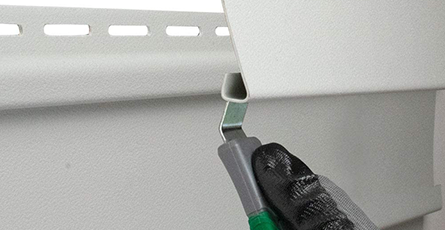
How to replace mid-wall of vinyl siding

Have a piece of cracked or melted vinyl? Did your bbq get a little too close to the house at your Labor Day Picnic? Check out this tutorial below to learn how to remove and fix a piece of damaged siding mid-wall easily with our PacTool Vinyl Siding tools.

Whether this is your first time DIY fixing your siding, or you're a siding professional, here at Pactool we want to make the job faster and easier with the right tools to get the job done.
Step One: Removing the Broken Piece
To some, this may be the most intimidating task of the entire job. Without proper removal, you could easily damage a perfectly good piece on Vinyl on your home. Luckily, this is one that if done properly can easily save you time and frustration with the proper tool.

While in theory, lifting the bottom of the siding with your hands could result in what you need, more times than not with the thinness and sometimes aging of the vinyl this quickly results in damage to the vinyl you're removing as well as the perfectly intact vinyl on top or below it.
Using our Straight Handled Siding Removal Tool you can easily lift from the bottom starting at the nearest joint (end of plastic siding usually distinguishable by a line break) or in the middle of the vinyl and gently glide along the bottom exposing the nails.
This siding tool saves time and effort when removing damaged siding or replacing vinyl siding. The off-set blade protects your hands and knuckles from the siding surface while the comfort grip provides you with a non-slip grip. When you tuck the tool and slide it behind the siding, the curved tip securely grips the lip of the vinyl siding, helping it to quickly be removed.
Step 2: Removing Nails

Once the nails are exposed, using the claw of your hammer, or a nail puller remove the nails. If your new piece of vinyl already fits the gap you have in your siding you can move on to step 5 otherwise you can continue to step 3.
Step 3: Cutting Your Vinyl
Once the nails are removed, the next step is based on the assessment of the damage to your vinyl. If you have to remove the whole piece, you may do so, but in some circumstances, you may only have damage in one specific area of the siding so you may not want to remove the entire area. Using our
VA104 Siding Snips cutting siding is faster and easier, these cut through BOTH vinyl and aluminum siding. With the snap nose, you will even be able to cut in small spaces with ease. Not only do these snips save your hand, they also save your wallet by offering sharp, replaceable blades, no need to replace the entire tool.

*Important note*: Be sure to leave space at the end for the proper lapping. Cutting the vinyl to the exact length may lead to shrinking when changes in temperature occur.
A good tip would be to overlap the panel by 1/2 width of the notch, or approx. one inch. This may leave some space between nailing flanges but that is okay.
Step 5: Replacing the Vinyl
Cut the desired amount of vinyl to remove the damaged siding and then line it up back up. Remember when nailing the vinyl into the wall again. that you never want to nail it all the way back in. You want to leave about a dime's width of space between the nail and the flanges on the wall.
When nailing, don't nail every single slot on the siding. You want to space your nails about every 12-14 inches and place the nail in the center of the slot. This is to allow the siding to expand and contract with the temperature changes.
In the event that the nails do not align properly with the allotted slots, you can cut a new one or extend the nail slot using our VA102 Vinyl and Aluminum Snap Lock Punch.
Step 6: Reattaching the top piece of siding
Using the Straight Handled Siding Removal Tool you can lift the bottom of the siding and easily snap it back to place on top of the new replacement siding the same easy way you used the tool to lift it up and off.
And just like that your all complete!
Click here for more information about our Vinyl Siding tools and their variety of uses or to purchase.
← Previous Post Next Post →